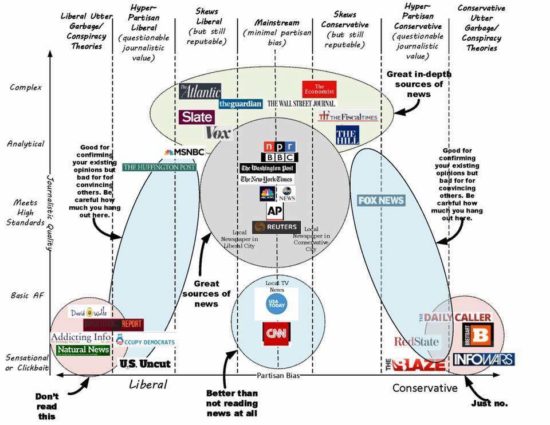I can’t stress enough how important it is to us – and our clients – that we work with trusted news sources. We rely on them to disseminate our clients’ announcements, quote executives as credible expert sources and provide us with the most up-to-date facts and current events.
Prior to 2017, fake news was defined as a source deliberately publishing propaganda, hoaxes and intentionally misleading information. It could be disguised as fictitious articles intending to generate profit through clickbait, fabricated content hoping to go viral, rumors or gossip, and more. Most people with an ounce of media literacy could tell the difference between “fake” and “real” stories fairly easily.
However, since the 2016 election, the definition of “fake news” has become increasingly vague.
Today, “trusted sources” seem to be a matter of opinion. The below graphic breaks it down pretty interestingly:

Source: https://imgur.com/7xHaUXf
While a news organization may be legitimate, if it skews heavily liberal or heavily conservative, it’s unlikely to be trusted widely. And, while a publication may reflect some minimal bias, it may not necessarily be “fake” news. Whether news is real or not is not a matter of whether the reader likes or agrees with the story.
Ever see those stories shared by your friends on Facebook and wonder whether or not they are legitimate? From my unscientific, public relations-minded perspective, here is an unofficial list of what may constitute present-day fake news versus real news.
Fake news
- Has a questionable domain or URL (may end in something like .com.co)
- Cites only one source, or none at all
- Stories are formulated around speculation
- Stories are formulated around a single opinion, rather than all sides of the story’s multiple perspectives
- Language is sensational and/or embellished
- States conspiracy theories
- Heavy partisan bias
- Not reported on by any other news outlets
- Notes an older publish date and time, or none at all
Real news
- Cites multiple sources from differing perspectives
- Language is straightforward
- Facts are proven with reports or statistics
- Does not cite “alternative facts”
- Headline is truthful and reflects the story
- Contains all elements of a story – not just selective components
- Minimal partisan bias
- Journalist has a reputable history of fair stories
- Publish date and time is recent
How do you judge the legitimacy of news?